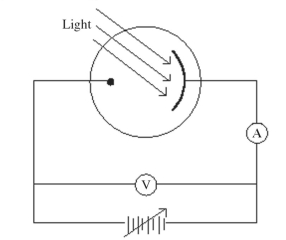Multiple Choice
Monochromatic light is incident on a metal surface, and the ejected electrons give rise to a current in the circuit shown in the figure. The maximum kinetic energy of the ejected electrons is determined by applying a reverse ('stopping') potential, sufficient to reduce the current in the ammeter to zero. If the intensity of the incident light is increased, how will the required stopping potential change?
A) It will increase.
B) It will decrease.
C) It will remain unchanged.
Correct Answer:

Verified
Correct Answer:
Verified
Q1: For a certain metal, light of
Q2: Consider the Bohr model for the
Q3: The work function of a certain
Q4: The distance between adjacent orbits in
Q6: A proton and an electron are
Q7: What is the shortest wavelength of
Q8: What is the momentum of a
Q9: When it is struck by
Q10: Hydrogen atoms can emit four spectral lines
Q11: What is the wavelength of a